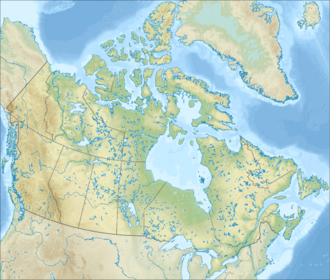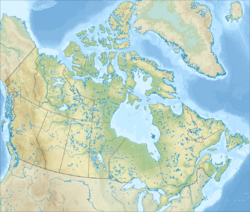Collines Montérégiennes
| Collines Montérégiennes | |
| Bergskedja | |
| Land | |
|---|---|
| Provins | Québec |
| Region | Montérégie, Montréal, Estrie |
| Koordinater | 45°28′24″N 73°03′09″V / 45.47331°N 73.05239°V |
| Tidszon | EST (UTC-5) |
| - sommartid | EDT (UTC-4) |
| Geonames | 5925866 |
Collines Montérégiennes är en bergskedja i provinsen Québec i Kanada, bestående av isolerade berg med gemensamt vulkaniskt ursprung.[1] Den är uppkallad efter Mont Royal i Montréal.[1] Kedjan fortsätter österut från Montréal genom regionerna Montérégie (som har fått namn efter kedjan) och Estrie.[1]
Ingående berg (västerifrån)
- Mont Royal
- Mont Saint-Bruno
- Mont Saint-Hilaire
- Mont Rougemont
- Mont Yamaska
- Mont Shefford
- Mont Brome
- Mont Saint-Grégoire
Ibland räknas även Collines d'Oka (väster om Mont Royal i regionen Laurentides) och Mont Mégantic (öster om Mont Saint-Grégoire) till kedjan.[1]
Källor
- ^ [a b c d] ”Collines Montérégiennes” (på franska). Commission de toponymie Québec. https://toponymie.gouv.qc.ca/ct/ToposWeb/Fiche.aspx?no_seq=76975. Läst 27 maj 2024.
Externa länkar
 Wikimedia Commons har media som rör Collines Montérégiennes.
Wikimedia Commons har media som rör Collines Montérégiennes.
Media som används på denna webbplats
Kanadas flagga, införd 1965; denna version med Pantone‐nyanser. Nuvarande utformning ersatte den tidigare kanadensiska Red Ensign.
Författare/Upphovsman: Nzeemin, Licens: CC BY-SA 3.0
Relief map of Canada.
- Projection: Lambert Conformal Conic Projection
- lon0 = -27°
- lat0 = 69°
- lat1 = 51°
- lat2 = 45°
- Projection/coords for GMT:
-Jl-95/49/49/77/1:29350000 -R-121.36/38.29/-11.5/63.0r
Shiny red button/marker widget. Used to mark the location of something such as a tourist attraction.
Astronaut photo of the Monteregian Hills, Quebec, Canada. Credit: International Space Station Crew Earth Observations experiment and the Image Science & Analysis Laboratory, Johnson Space Center The description from that page follows below.
- This astronaut photograph of the area to the east of Montreal, Canada, captures two striking patterns. The circular features are the central members of a group of unusual rock formations known as the Monteregian Hills: Mont St. Hilaire, Rougemont, and Mont Yamaska. The rectangular pattern blanketing the landscape in the background reveals the intensive agriculture in the fertile lowlands in southern Quebec.
- The Monteregian Hills are an isolated series of roughly east-west trending plutons, masses of igneous (volcanic) rock that crystallized below the land surface. The magmas that form the Hills intruded into pre-existing sedimentary rocks roughly 118 to 140 million years ago, during the Cretaceous Era. Over time, the sedimentary rock has eroded away, leaving the more resistant igneous rock of the plutons exposed as the Monteregian Hills, standing over the surrounding, flat St. Lawrence Plains.
- Snow cover on the three mountains provides contrast with surrounding fallow agricultural fields, which are shades of brown and tan. A bright white circle nestled on top of Mont St. Hillaire is snow-covered Lac Hertel (Hertel Lake). In addition to their interesting geology, the Monteregian Hills also serve as important woodland habitat “islands” in the greater Montreal urban area. Several small town and cities are visible in the image, appearing as purplish-gray patches. The largest in the scene is the city of Beloeil, straddling the Richelieu River west of Mont St. Hilaire.
- The featured astronaut photograph, ISS014-E-19807, was acquired April 18, 2007, with a Kodak 760C digital camera using an 180 mm lens, and is provided by the ISS Crew Earth Observations experiment and the Image Science & Analysis Laboratory, Johnson Space Center. The image in this article has been cropped and enhanced to improve contrast. The International Space Station Program supports the laboratory to help astronauts take pictures of Earth that will be of the greatest value to scientists and the public, and to make those images freely available on the Internet. Additional images taken by astronauts and cosmonauts can be viewed at the NASA/JSC Gateway to Astronaut Photography of Earth.





